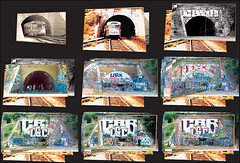Graffiti Archaeology

Graffiti Archaeology
Originally uploaded by ideateller.
From the
href="http://www.nytimes.com/2005/06/21/arts/design/21boxe.html?ex=111958560
0&en=ef187607c2bbbab5&ei=5070">NYTimes
Digital 'Antigraffiti' Peels Away the Years
By SARAH BOXER
Published: June 21, 2005
This month the International Academy of Digital Arts and Sciences awarded
its annual Webby (the online equivalent of an Oscar) for the best art site
to Graffiti Archaeology, grafarc.org, a pictorial study of graffiti-covered
walls as they evolve. At first entry, the site looks like Batman's cave
bathed in blue light. You go spelunking along a railroad track until you
reach the heart of Graffiti Archaeology. There you will find a list of eight
locations in California (most in San Francisco) where graffiti grows, gets
erased and grows again.
Skip to next paragraph
Enlarge This Image
From top left: Jim Stubchaer (1949); Bill Volkmer (1955); Martin Schall
(2000); Graffiti V?rit? (2002); Ladytribe (2003); Amy McKenzie (March 2004,
May 2004); Aaron Bocanegra (July 2004); Cassidy Curtis (August 2004).
A Tunnel's Tale A historical photo of the Belmont Tunnel in Los Angeles,
1949, top left. The award-winning Web site Graffiti Archaeology traces the
tunnel's evolution from 1955, top center. From top right: the shifting look
from 2000 through August 2004, bottom right.
Related Web Site: Graffiti Archaeology
Readers
Forum: Artists and Exhibitions
Enlarge This Image
Jonathan Tobin
An Updated Look The Belmont Tunnel, Nov. 6, 2004, on the Graffiti
Archaeology site.
The creator of the site, Cassidy Curtis, a San Francisco animator in his
30's, isn't just being cute when he calls it "graffiti archaeology." It
really is archaeology. You start at the surface and then peel away layers to
look into the past. When you choose one of the locales and pick which wall
you want to see, you are shown a recent photograph first. Then you can move
backward in time or hop around, using a timeline at the bottom of the page.
You can also zoom in to see details and navigate around the surface of the
walls.
In effect, Mr. Curtis has made antigraffiti. He uncovers the layers that
each successive graffiti artist has covered up.
What's amazing is that Mr. Curtis, who was a character animator for the
movie "Madagascar," constructed his archaeological site not by taking all
the pictures himself (though he did take a lot of them) but by finding other
photographers' work and stitching together a history. At the top of each
picture is a label saying when the photograph was taken and by whom.
Take the case of the he Belmont Tunnel wall in Los Angeles. The most recent
photograph, taken on Nov. 6, 2004, by Jonathan Tobin, shows huge letters,
CAR, arched over a bricked-up tunnel. Below are blobby blue and white
letters and, farther down, scribbles.
Peel a layer back, to August 7, 2004, and CAR is still there, but just about
everything else is different. Instead of blobby blue letters, you see the
blocky black and white letters, LSC, about to be flooded by a rising tide of
shapes, colors and alphabetic flotsam.


0 Comments:
Post a Comment
<< Home